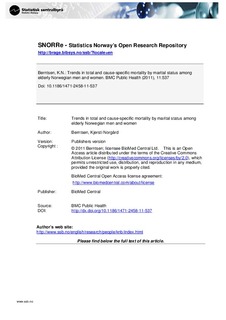| dc.contributor.author | Berntsen, Kjersti Norgård | |
| dc.date.accessioned | 2012-07-16T11:33:03Z | |
| dc.date.available | 2012-07-16T11:33:03Z | |
| dc.date.issued | 2011 | |
| dc.identifier.citation | Berntsen: Trends in total and cause-specific mortality. BMC Public Health (2011), 11:537 | no_NO |
| dc.identifier.issn | 1471-2458 | |
| dc.identifier.other | doi:10.1186/1471-2458-11-537 | |
| dc.identifier.uri | http://hdl.handle.net/11250/178120 | |
| dc.description | © 2011 Berntsen, K.N.; licensee BioMed Central Ltd. This is an Open Access article distributed under the terms of the Creative Commons Attribution License (http://creativecommons.org/licenses/by/2.0), which permits unrestricted use, distribution, and reproduction in any medium, provided the original work is properly cited. Licence agreement: http://www.biomedcentral.com/about/license | no_NO |
| dc.description.abstract | Background: Previous research has shown large and increasing relative differences in mortality by marital status in
several countries, but few studies have considered trends in cause-specific mortality by marital status among
elderly people.
Methods: The author uses discrete-time hazard regression and register data covering the entire Norwegian
population to analyze how associations between marital status and several causes of death have changed for men
and women of age 75-89 from 1971-2007. Educational level, region of residence and centrality are included as
control variables. There are 804 243 deaths during the 11 102 306 person-years of follow-up.
Results: Relative to married persons, those who are never married, divorced or widowed have significantly higher
mortality for most causes of death. The odds of death are highest for divorcees, followed by never married and
widowed. Moreover, the excess mortality among the non-married is higher for men than for women, at least in
the beginning of the time period. Relative differences in mortality by marital status have increased from 1971-2007.
In particular, the excess mortality of the never married women and, to a lesser extent, men has been rising. The
widening of the marital status differentials is most pronounced for mortality resulting from circulatory diseases,
respiratory diseases (women), other diseases and external deaths (women). Differences in cancer mortality by
marital status have been stable over time.
Conclusions: Those who are married may have lower mortality because of protective effects of marriage or
selection of healthy individuals into marriage, and the importance of such mechanisms may have changed over
time. However, with the available data it is not possible to identify the mechanisms responsible for the increasing
relative differences in mortality by marital status in Norway. | no_NO |
| dc.language.iso | eng | no_NO |
| dc.publisher | BioMed Central | no_NO |
| dc.subject | Dødelighet | no_NO |
| dc.subject | Dødsårsaker | no_NO |
| dc.subject | Ekteskaplig status | no_NO |
| dc.subject | Sivilstand | no_NO |
| dc.subject | Eldre | no_NO |
| dc.subject | Norge | no_NO |
| dc.subject | Menn | no_NO |
| dc.subject | Kvinner | no_NO |
| dc.subject | Mortality | no_NO |
| dc.subject | Women | no_NO |
| dc.subject | Men | no_NO |
| dc.subject | Elderly | no_NO |
| dc.subject | Scientific article | |
| dc.title | Trends in total and cause-specific mortality by marital status among elderly Norwegian men and women | no_NO |
| dc.type | Journal article | no_NO |
| dc.type | Peer reviewed | no_NO |
| dc.subject.nsi | VDP::Medical disciplines: 700::Health sciences: 800 | no_NO |
| dc.subject.nsi | VDP::Social science: 200::Demography: 300 | no_NO |
| dc.source.pagenumber | 10 s. | no_NO |
| dc.source.volume | Volume 11 | no_NO |
| dc.source.journal | BMC Public Health | no_NO |
